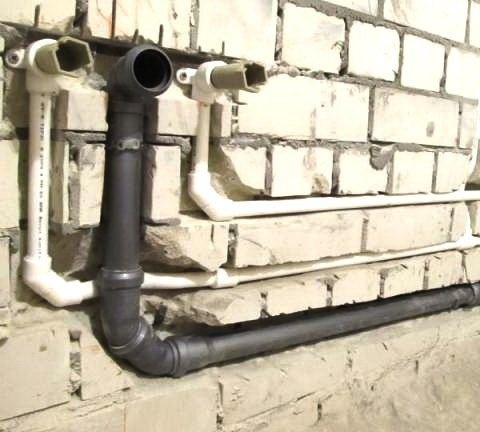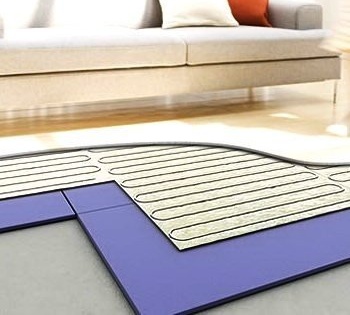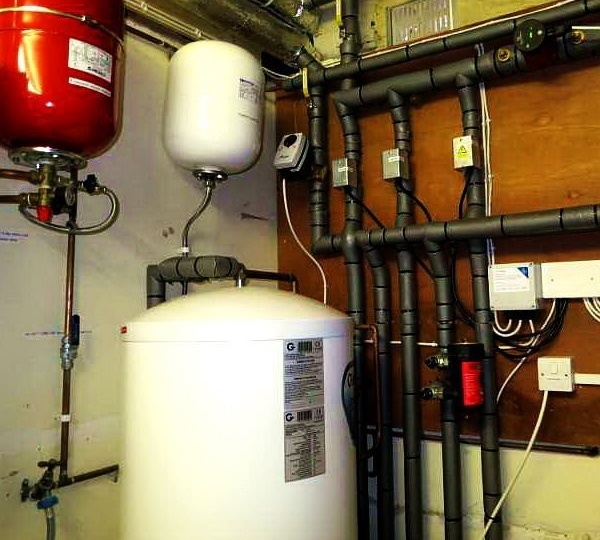We choose a heater for pipes: which is better for water supply, and which for sewage and heating
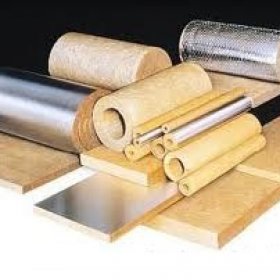
Any pipeline located outside the premises needs insulation. The exception is highways laid below the depth of freezing. Thermal insulation of pipelines located in unheated rooms is also required. Warming increases the functionality of communication lines and their service life. High-quality insulation for pipes reliably protects them from freezing, reduces heat loss of heating systems and eliminates the formation of condensate.
Content
What insulation material is used for pipes?
The choice of insulation depends on the purpose of the line, operating conditions and pipe diameter. Regardless of the type of insulated systems, the material for thermal insulation must have:
- low thermal conductivity;
- fire resistance, it is advisable to use self-extinguishing materials;
- resistance to external influences;
- ease of installation, an important characteristic for those who want to produce insulation on their own;
- water resistant, if the insulation absorbs moisture, this greatly reduces its thermal insulation characteristics and service life;
- durability.
Most often, thermal insulation for pipes is made of the following materials:
- fibrous materials;
- penoplex;
- polyurethane foam;
- heat insulating paint.
Fibrous materials for thermal insulation of pipelines
Fibrous materials for thermal insulation are made from slags of the metallurgical industry, fiberglass or basalt stones. Slag mineral wool is prohibited for indoor use due to negative effects on the human body. In addition, it loses its physical and thermal insulation characteristics under the influence of high humidity and critical temperatures.
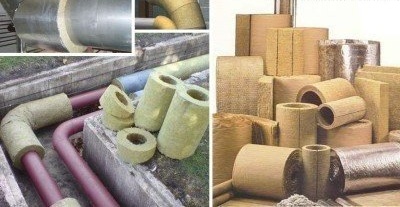
Mineral wool heat-insulating cylinders are selected depending on the thickness of the insulated pipes. The aluminum foil covering the cylinders acts as a waterproofing
Fiberglass insulation is made from waste from the glass industry. It has high elasticity, chemical resistance and is not subject to deformation. Mineral wool from basalt rocks has high thermal insulation properties, resistance to mechanical stress and corrosion, fire resistance. Fibrous insulation materials are available either in rolls or in the form of cylinders.For all heaters of this type, additional waterproofing or impregnation with water-repellent compounds is required.
Penoplex - insulation from extruded polystyrene
Penoplex for thermal insulation of pipes is produced in the form of plates or segments. It is an extruded polystyrene, which has a uniform structure filled with closed cells. Penoplex is not biodegradable, which ensures its long service life. In addition, it is non-combustible, non-toxic, has low thermal conductivity and has high compressive strength.
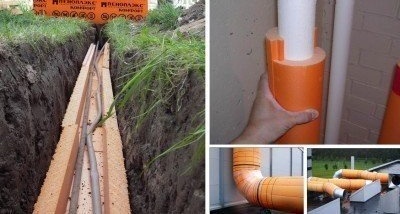
To insulate the pipeline, foam strips of the material of the required size are cut with penoplex, then they are laid at the bottom of the trench under the pipeline, and then around the pipes
According to the assurances of the manufacturers, penoplex was tested by repeated freezing and thawing of the product. After such manipulations, the material retained its physical and thermal properties. However, under the influence of ultraviolet radiation for a long time, the top layer of the product may be destroyed.
Three methods of thermal insulation of pipes with polyurethane foam
Polyurethane foam is a type of gas-filled plastic with a cellular structure. It consists of small capsules, 90% of which are closed and filled with carbon dioxide. Due to this structure, polyurethane foam insulation has unique thermal insulation properties. There are three methods of pipe insulation using PPU:
- installation of heat-insulating "shell";
- spraying liquid polyurethane foam;
- pipe pre-insulation.
Thermal insulation "shell" is a half-cylinder made of polyurethane foam. Such blanks are made of various shapes and thicknesses. Insulation is fixed using tape, wire, clamps. A distinctive feature of the heat-insulating "shell" is the ability to dismantle it during repair work and repeated use. To increase the service life, the insulation surface is covered with aluminum foil, galvanized metal or fiberglass. This gives the material extra strength and protects against ultraviolet radiation.
The use of liquid foam does not allow re-use. The thickness of the insulation layer after spraying can reach 1.5 cm. The insulation characteristics of the insulation depend on it. After spraying the liquid composition, foaming of the polyurethane foam occurs and its strong adhesion to the pipe. Due to this, a sealed layer appears on the surface of the pipeline.
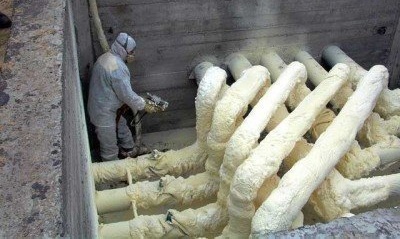
The application of liquid polyurethane foam on the pipes is carried out using special sprayers. During this process, personal protective equipment must be used.
A monolithic coating is formed, which does not lose operational properties even from the influence of ultra-low and high temperatures. Such characteristics make it possible to use polyurethane foam even on cryogenic plants. PPU spraying can be used on pipelines of various configurations and thicknesses. The process of insulation is carried out using special equipment.
Pipes with pre-insulation are covered with a layer of insulation made of polyurethane foam in the factory. The design of such products consists of three layers: directly a steel pipe covered with an insulating layer, which is protected by a shell. For surface highways, pipes with a sheath made of galvanized steel are produced, for underground - from polyethylene. The protective layer gives the product additional strength and resistance to aggressive environments and temperature extremes.
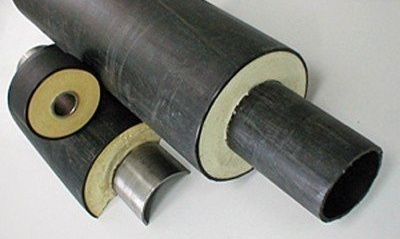
In the manufacturing process, pre-insulated pipes are aligned parallel to the containment. Therefore, the distance between them should be the same along the entire perimeter
Heat-insulating paint as a heater
Not so long ago, a new insulating material appeared on the construction markets - heat-insulating paint.The main components of such products is an acrylic dispersion diluted with varnish or water with the addition of various fillers. The paint has a pasty appearance. To apply it to the pipes use a spray gun. For small areas, you can use a brush. Such a heater is good for metal pipes, as it is a good protection against corrosion. Manufacturers guarantee a service life of a coating of heat-insulating paint at least 15 years.
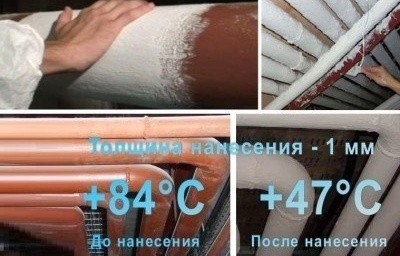
The application of heat-insulating paints in small areas or in inaccessible places is done with a brush. Heat insulation with paint can be made on pipes of any configuration.
Which highways need insulation?
Thermal insulation material is used for heating, plumbing and sewer lines.
Thermal insulation of heating systems
Heating mains need to be insulated if they are outdoors, in an unheated room, walled up in the floor or walls. Otherwise, due to the large heat loss, their functionality is reduced. Not so long ago, mineral wool was the main insulation for pipes, including heating pipes. Today, in addition to this, modern materials have begun to be used: polyurethane foam, penoplex, fibrous heaters. Due to the fact that in winter the heating mains attract the attention of rodents, it is advisable to use a more durable insulation or to provide additional protection for their thermal insulation.
Features of insulation of water pipes
The main task of the insulation for water mains is to save the pipes from exposure to low temperatures. If the water supply is made of metal pipes, thermal insulation will serve as protection against corrosion. Liquid polyurethane foam is perfect for this. In addition, the insulation for water pipes eliminates condensation, extending their service life.
Is sewer line insulation required?
It is unambiguous to say whether a heater is needed for sewer pipes. It all depends on the specific case. If you do not want to have problems, heat-insulate sewers with insufficient slope, deepened into the ground by less than half a meter and have turns. Insulation is also necessary for sewer pipes, which are periodically clogged.
Insulation of pipes is not the process that is worth saving on. Negligence allowed in the choice of material for thermal insulation can result in additional waste in the event of freezing of the pipeline and its failure.
